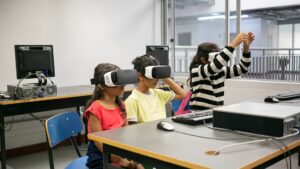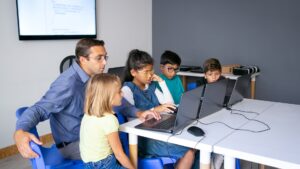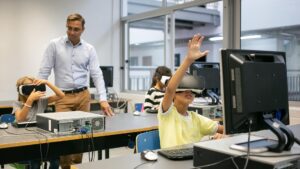EdTech, or education technologies, are a crucial part of modern classrooms since they have revolutionized how teachers and students learn. Due to advancements in digital tools and platforms, modern classrooms are free from the constraints of old methods, providing dynamic and varied learning environments that are customized to each student’s needs. Nonetheless, Education Tech is changing the learning environment, and it is essential to modern education.
It is important to comprehend the concept of modern education and classrooms too. Modern classrooms are educational spaces that have evolved to include technology, adaptable learning environments, and inclusive teaching techniques to fulfill the demands of today’s students. Modern classrooms emphasize student-centered learning, digital integration, and adaptability more than traditional classrooms, which frequently have rows of desks and teacher-centered education.
What is educational technology?

Nonetheless, more than just a tool, education technology is a vital component of contemporary education that enhances the educational process, empowers students, and helps teachers. Schools are giving kids the abilities, experience, and flexibility they need to succeed in a technologically advanced society by incorporating EdTech into the classroom. Technology’s position in education will only grow more important as it develops further, opening up new avenues for creative, inclusive, and influential learning.
This teaching of technology refers to a broad category of instruments, programs, and approaches intended to improve administration, instruction, and learning in educational environments. It involves incorporating digital technologies and methods to enhance the educational process, making learning more efficient, effective, accessible, and individualized.
Furthermore, here are some of the elements of education technologies;
Hardware: Equipment used in schools to support digital learning, including projectors, interactive whiteboards, tablets, and computers.
Software: includes learning management systems (LMS) such as Google Classroom or Canvas, educational apps, online tests, and e-books that facilitate interactive learning and help teachers educate.
Digital tools: include simulations or virtual labs for practical science experiments, Kahoot for quizzes, and Zoom for online classrooms.
Assistive technology: includes tools and programs like screen readers, audiobooks, and speech-to-text software that make learning easier for students with impairments.
How EdTech is revolutionizing the learning environment?

-
Personalized Educational Opportunities
EdTech’s capacity to provide students with individualized learning experiences is among its most important advantages. Teachers can modify information to fit the individual requirements, interests, and speed of each student due to technology.
Students can concentrate on their areas of greatest need with the use of technologies like AI-driven tests and adaptive learning software, which makes learning more effective and pleasurable.
-
Higher Involvement of Students
To provide captivating learning experiences, EdTech uses interactive tools like augmented reality, digital simulations, and gamified teaching. These resources increase students’ motivation and focus by making difficult ideas more approachable and enjoyable.
According to studies, students who are actively involved in their education typically retain material better, which improves their academic performance.
-
Availability of Worldwide Resources
Students can access a wide range of international resources through EdTech, such as online courses, digital libraries, and multimedia content from top universities.
Students are able to investigate topics outside of the regular curriculum, develop global awareness, and broaden their viewpoints due to this exposure to various learning resources.
-
Teamwork and Interaction Abilities
Students collaborate more both inside and outside of the classroom due to education technologies. Collaboration and communication are facilitated by tools like video conferencing, interactive whiteboards, and cloud-based document sharing in education and technology.
By working on projects, exchanging ideas, and resolving issues together, these collaborative platforms help students develop critical skills for the modern workforce.
-
Effective Evaluation and Input
Education Tech solutions streamline the evaluation process while giving educators instant access to data on student achievement and areas in need of development. Digital grade books, data analytics, and automated tests enable teachers to monitor student progress and provide personalized feedback.
By concentrating on particular needs, this streamlined procedure of teaching of technology not only saves time but also improves the quality of education.
-
Preparation for a Technology-Driven Future
It is essential for learners to be at ease and proficient with technology in the quickly evolving digital world. Students gain technical skills and digital literacy by integrating EdTech into the classroom, preparing them for future employment.
They will benefit throughout their life by knowing how to use software, navigate virtual platforms, and apply critical thinking in tech-driven contexts.
-
Assistance for Fluctuating Learning Requirements
EdTech helps to establish inclusive classrooms where all students may thrive by accommodating a variety of learning needs and styles.
In order to create an equal learning environment, assistive technologies such as audio readers, speech-to-text, and adjustable displays make sure that students with learning differences or disabilities can access and interact with content in an efficient manner.
Education and technology: What makes modern classrooms unique?

Dynamic, flexible, tech-friendly, and student-centered learning environments are produced in modern classrooms. To educate students for success in the quickly evolving world of today, modern classrooms use digital technologies, encourage collaboration, and support inclusive and individualized learning.
-
Integration of education technologies
A variety of education and technology tools, including digital projectors, tablets, laptops, and interactive whiteboards, are available in modern classrooms. Students can access resources, participate in interactive courses, and work together on projects utilizing digital tools due to this technology, which supports a variety of instructional approaches.
- Learning management systems (LMS) such as Google Classroom or Canvas, digital textbooks, online research tools, and interactive smartboards are a few examples of teaching of technology.
-
Adaptable Learning Environments
Modern classrooms are made with flexibility in mind and this is further facilitated by EdTech. To encourage cooperation and active learning in education technology, desks, and chairs can be moved to make room for discussion circles, group projects, or private study sessions.
- Examples: include flexible seating that can be rearranged to accommodate various learning activities, standing workstations, movable desks, and comfortable reading nooks.
-
Opportunities for Blended Learning
With blended learning, students have more control over their learning style and pace by combining traditional in-person education with online or digital activities. By using this approach, educators can improve student engagement and comprehension by integrating videos, interactive tests, and virtual simulations into their classes.
- Examples of this education and technology aspect include the “flipped classroom” paradigm, which uses video courses that students can view at home, educational apps, or online tests.
-
Personalized Education
Personalized learning tactics are frequently used in modern classrooms due to education technologies, where teachers modify their lessons to fit each student’s particular needs and learning preferences. Here, technology is crucial because it makes adaptive software possible, which adapts content to students’ skill levels and gives immediate feedback.
- Examples are digital reading helps that let kids read at their own pace or adaptive math software that modifies the level of difficulty according to student success.
-
Put Communication and Cooperation First
A key component of modern education technologies is collaboration. Students develop critical communication skills by cooperating in groups, working on projects together, and exchanging ideas online. Additionally, this EdTech method equips students with a world that is increasingly networked and where networking and teamwork are essential.
- Examples include class discussions via online forums or classroom blogs, and group projects utilizing cloud-based platforms like Zoom or Google Docs.
-
A focus on SEL (social-emotional learning)
Modern classrooms place a high priority on social-emotional learning due to EdTech, which helps in the development of empathy, self-awareness, and emotional control in students. To create a nurturing and understanding classroom environment that supports students’ academic and personal growth, teachers integrate SEL into their teachings.
- Examples of these education technologies include SEL-focused applications, daily check-ins with kids, and mindfulness and empathy-boosting activities in the classroom.
-
Data-Driven Teaching
In modern classrooms, technology enables instructors to collect information on student performance and growth, which helps them make well-informed decisions about education. Teachers can tailor the learning process by identifying which students require more assistance or challenges through data analysis.
- Examples include dashboards that show performance trends for specific students, digital tests that offer instant feedback, and learning management system (LMS) systems that monitor student involvement.
EdTech: To what extent does technology play a role in education?

Technology has emerged as a key component of modern education, influencing how teachers teach, how students learn, and how schools function. Since education and technology provide a multitude of advantages that improve learning, expand accessibility, and equip students for a technologically advanced future, its significance in education cannot be low-key.
- Through interactive tools and multimedia information that make difficult subjects more approachable and interesting, education technologies make learning more dynamic.
- EdTech capacity to customize education is among its most important benefits. Teachers can modify classes to each student’s individual needs, learning styles, and aptitudes by using digital platforms and adaptive learning software. Students, particularly those who would find it difficult in conventional, one-size-fits-all settings, benefit from this tailored approach and feel encouraged to succeed.
- The technology ensures that everyone has an equal chance to achieve by removing barriers for students with learning disabilities and difficulties. Students with visual, auditory, or movement disabilities can access learning materials due to assistive technologies including screen readers, speech-to-text software, and adjustable display settings.
- Teaching of technology in education or education technologies is essential for educating students for future employment in a world where digital skills are becoming more and more valuable. Teachers can help students develop the skills they need to succeed in a tech-centric workforce by incorporating technology into the classroom, from fundamental computer literacy to more complex abilities like coding and data analysis.
- Students, instructors, and even parents can work together more easily because to technology. Students can collaborate on projects regardless of where they are due to cloud-based tools, discussion boards, and video conferencing services. Additionally, it is easier for parents and teachers to communicate, which helps to guarantee that children stay on course and receive constant support.
- Flexible learning methods made possible by education technologies, such as online and hybrid courses, enable students to access education regardless of their physical or geographic limits.
- Teachers have less administrative work to do due to EdTech, which frees up more time for instruction and student support. These procedures are streamlined by grading, attendance, and lesson planning tools, which help teachers better, manage their workload and produce more impactful lesson plans.
- Teachers can use the useful data that technology offers to enhance their instructional methods. Teachers can evaluate progress, find learning gaps, and modify their teaching strategies to better suit the needs of each class by evaluating student performance.
- Nonetheless, Technology plays an essential part in schooling. Education has improved as a result of technology. Using education technologies in the classroom is about building a vibrant, inclusive, and progressive educational system that gives students the tools they need to succeed.













